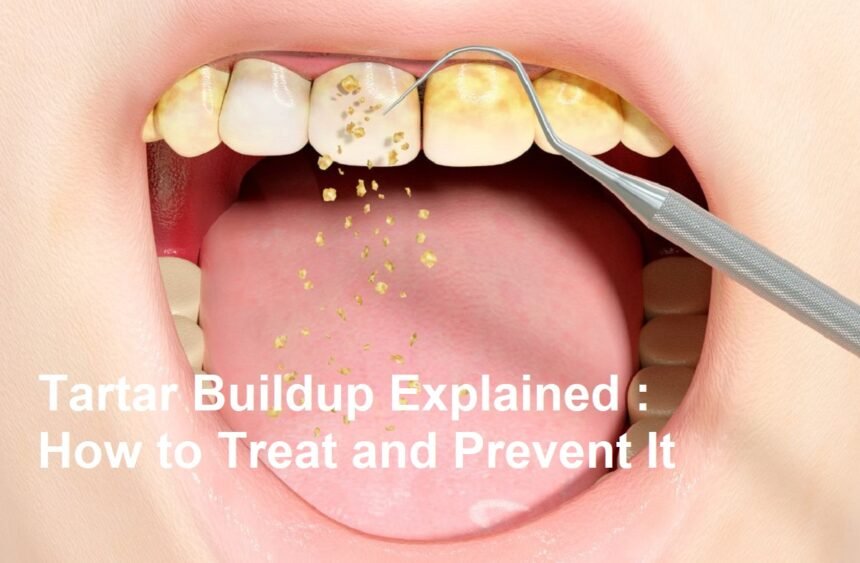Introduction
Maintaining good oral hygiene is essential for overall health, yet many people overlook a common dental issue—tartar buildup. Tartar, also known as dental calculus, is a hardened form of plaque that adheres firmly to the teeth and gums. If not addressed, it can lead to cavities, gum disease, and other serious dental problems. This article explores the causes of tartar, how to treat it, and effective prevention strategies.
What Is Tartar and How Does It Form?
Tartar is mineralized plaque that forms when plaque, a sticky film of bacteria, sugars, and food particles, is not removed through regular brushing and flossing. Over time, the plaque hardens due to the mineral content in saliva, turning into tartar. Unlike plaque, which can be removed through regular brushing, tartar requires professional cleaning for removal.
Formation Process:
- Plaque Accumulation: Daily food intake and poor oral hygiene lead to the formation of plaque on teeth surfaces.
- Mineralization: Plaque begins to mineralize within 24 to 72 hours, especially in areas that are difficult to clean.
- Tartar Formation: As mineralization continues, it hardens, attaching tightly to the enamel and along the gum line, forming tartar.
Causes of Tartar Buildup
Several factors contribute to the rapid development of tartar:
- Poor Oral Hygiene: Infrequent brushing and flossing allow plaque to accumulate and mineralize.
- Diet: Consuming sugary, starchy foods promotes plaque formation.
- Irregular Dental Visits: Skipping professional dental cleanings allows tartar to build up undisturbed.
- Genetics: Some individuals are genetically predisposed to plaque and tartar buildup due to saliva composition or tooth structure.
- Age: As people age, saliva flow decreases, making it easier for plaque to mineralize.
- Dry Mouth: Reduced saliva flow, often due to medications or health conditions, impedes the natural cleansing process.
How to Treat Tartar Buildup
Once tartar forms, it cannot be removed by brushing alone. Professional dental cleaning, called scaling, is necessary to eliminate tartar from teeth surfaces and below the gum line.
Treatment Methods:
- Scaling and Root Planing: A dentist or dental hygienist uses specialized tools to clean tartar from teeth and smooth out root surfaces.
- Polishing: After scaling, teeth are polished to remove plaque residues and make the surface less hospitable to bacteria.
- Addressing Gum Disease: If tartar has led to gingivitis or periodontitis, additional periodontal treatments may be recommended.
Prevention of Tartar Buildup
Prevention is always better than treatment. Here are effective strategies:
- Regular Brushing: Brush teeth at least twice daily with fluoride toothpaste, ensuring thorough cleaning of all surfaces.
- Floss Daily: Flossing removes plaque between teeth and along the gum line where brushes cannot reach.
- Use Mouthwash: Antimicrobial mouthwashes help reduce plaque and bacteria.
- Maintain a Healthy Diet: Limit sugary and starchy foods that promote plaque formation.
- Visit the Dentist Regularly: Schedule professional cleanings at least twice a year for preventive care.
- Avoid Tobacco and Alcohol: Both can contribute to plaque buildup and gum disease.
- Use Proper Brushing Technique: Use a soft-bristled toothbrush and replace it every 3-4 months.
Additional Tips for Good Oral Health
- Consider using electric toothbrushes for more effective plaque removal.
- Use interdental brushes or water flossers if traditional flossing is challenging.
- Stay hydrated to promote saliva flow, which naturally cleanses the mouth.
- Incorporate dental sealants or fluoride treatments as advised by your dentist.
Conclusion
Tartar buildup is a common but preventable dental issue that can lead to serious oral health problems if neglected. Understanding its causes—including poor oral hygiene, diet, and age—helps in taking proactive steps. Regular professional cleanings combined with good daily habits are the keys to keeping tartar at bay. Prioritize your dental health today to enjoy a brighter, healthier smile tomorrow.












